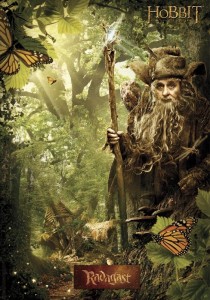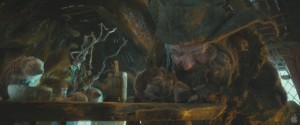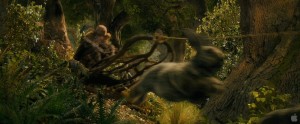Radagast and the tombs of the Nazgûl

In other words, if we stay faithful to the book’s geography, we’d see Haldir instead of Legolas at the battle—and we know we’re seeing Legolas. Furthermore, LOTR is meant to take place on a larger canvas than The Hobbit, so we want to leave some regions of Middle-earth unvisited until the later story. It thus makes sense to show us only one of the two great Elven refuges now, and that means highlighting Rivendell while writing Lórien out of the story. All of this explains why there are no reports that Lórien will be in the film, even though Galadriel will be.
Moving Dol Guldur northward also strikes me as an improvement on Tolkien; it’s always been a puzzle as to why Sauron would have built it a hundred miles due east of the home of the mightiest and most perceptive of the remaining Eldar of Middle-Earth. A location close to the middle of Mirkwood, halfway between the Old Forest Road and the Gladden Fields, makes more sense. Tolkien only located Rhosgobel in a late note, cited in Unfinished Tales (which Jackson has no rights to), but it would make sense for Jackson to put it where Tolkien did—near the Forest Road and hence on Thorin and Co.’s original intended route.
We can next ask, how can you introduce Radagast? Never mind that he’s barely in the book—he lives alone, meaning no one ever addresses him by name. The one way that’s easy and straightforward is to have the White Council introduce him by discussing his absence.

However it plays out, Radagast’s absence from the Council makes it clear that he and Gandalf initially have separate, independent storylines, where each finds evidence of Sauron’s return. That’s good storytelling. And like you, I am dying to find out just what Sauron can do to a hedgehog that would be as scary to Radagast as the re-animation of the dead is to Gandalf. But this invention of Jackson’s seems nicely in accord with the concern that Tolkien always shows for the natural world. A hedgehog by any other name would be a tree.
I’m guessing there’s at least one scene that escalates this initial discovery of hedgehog evil blight, before the big third act event: giant spiders attack and presumably destroy Rhosgobel. This has two related consequences: Radagast, driven out of Mirkwood, must go somewhere else, and he must relay this news to the Council as soon as possible. Now, we’re fairly certain that Radagast is a master of sending messages by animal, bird, or moth, but it would be intensely undramatic if he were able to able to pass this news along without any trouble. In terms of making things difficult for the good guys, it’s already problematical enough that Elrond and Galadriel can communicate telepathically. If Radagast never finds it a challenge to send messages, you’ve essentially given the rest of the White Council cell phones, albeit very slow ones and almost certainly running Windows. Sending messages has to take him time and effort.

Jackson being Jackson, the pursuit sequence will be garnished with an especially exciting incident or two (think crumbling bridge in Moria); we’ll see below that there’s probably one such incident good enough to function as a film-ending cliffhanger. There may be dramatic tension as we wonder whether Radagast will arrive at Beorn’s before Gandalf leaves (I’m guessing he doesn’t), and downright anxiety when we see that Beorn has left to accompany his guests to the eaves of Mirkwood, and won’t be there to defend Radagast against his pursuers. (That job could be handled by ordinary bears—but at this point I’m just making wild-assed guesses, and, what’s more, probably guesses about the beginning of the second film.)


